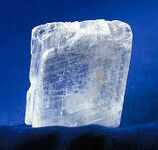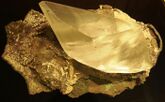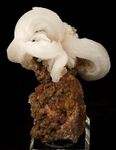Chemistry:Selenite (mineral)
| Selenite | |
|---|---|
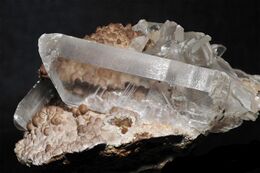 | |
| General | |
| Category | Sulfate mineral |
| Formula (repeating unit) | CaSO4·2H2O |
| Crystal system | Monoclinic (2/m) Space group: A2/a |
| Identification | |
| Formula mass | 172.17 |
| Color | Brown green, brownish yellow, greenish, gray green, gray white |
| Crystal habit | Earthy – dull, clay-like texture with no visible crystalline affinities, (e.g. howlite) |
| Cleavage | [010] Perfect, [100] Distinct, [011] Distinct |
| Fracture | Fibrous – thin, elongated fractures produced by crystal forms or intersecting cleavages (e.g. asbestos). |
| Mohs scale hardness | 2 |
| |re|er}} | Pearly |
| Streak | White |
| Specific gravity | 2.9 |
| Optical properties | Biaxial (+) 2V=58 |
| Refractive index | nα = 1.519–1.521, nβ = 1.522–1.523, nγ = 1.529–1.53 |
| Birefringence | δ = 0.0090–0.0100 |
| Other characteristics | Non-radioactive, non-magnetic, fluorescent |
| References | [1] |
Selenite, satin spar, desert rose, and gypsum flower are crystal habit varieties of the mineral gypsum.
All varieties of gypsum, including selenite and alabaster, are composed of calcium sulfate dihydrate (meaning that it has two molecules of water), with the chemical formula CaSO4·2H2O. Selenite contains no significant selenium – The similar names both derive from Greek selḗnē (σελήνη 'Moon').
Some of the largest crystals ever found are of selenite, the largest specimen found in the Naica Mine's Cave of the Crystals being 12 metres long and weighing 55 tons.
History and etymology
"Selenite" is mostly synonymous with gypsum,[2] but from the 15th century, it has named the transparent variety that occurs in crystals or crystalline masses. The name derives through Middle English Lua error in Module:Language at line 197: Name for the language code "enm" could not be retrieved with mw.language.fetchLanguageName, so it should be added to Module:Language/data. from Latin selenites, ultimately from Greek selēnítēs líthos (σεληνίτης λίθος, lit. moon stone). It got this name because people historically believed the mineral waxed and waned with the cycles of the Moon.[3]
Distinguishing characteristics
The main distinguishing characteristics of crystalline gypsum are its softness (hardness 2 on Mohs scale, soft enough to scratch with a fingernail) and its three unequal cleavages.[4][5] Other distinguishing characteristics include its crystal habits, pearly lustre, easy fusibility with loss of water, and solubility in hot dilute hydrochloric acid.[6]
Varieties
Though sometimes grouped together as "selenite", the four crystalline varieties have differences. General identifying descriptions of the related crystalline varieties are:
Selenite
- Most often transparent and colorless[7]
- If selenite crystals show opacity or color, it is caused by the presence of other minerals, sometimes in druse[8]
Satin spar
- Most often silky and fibrous;[9] chatoyant; can exhibit some coloration[10]
- The satin spar name has also been applied to fibrous calcite (a related calcium mineral), which can be distinguished from gypsum by its greater hardness (Mohs 3), rhombohedral cleavage, and reaction with dilute hydrochloric acid.[11]
Desert rose
- Rosette-shaped gypsum with outer druse of sand or with sand throughout – most often sand colored (in all the colors that sand can exhibit)[12]
- The desert rose name can also be applied to barite desert roses (another related sulfate mineral) – barite is a harder mineral with higher density[13]
Gypsum flower
- Gypsum flowers are curved rosettes of fibrous gypsum crystals found in solution caves.[14]
Use and history
Satin spar is sometimes cut into cabochons to best display its chatoyance.[15]
Crystal habit and properties
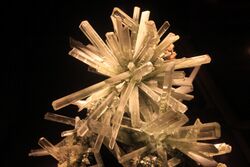
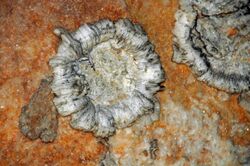
Crystal habit refers to the shapes that crystals exhibit.[16] Selenite crystals show a variety of habits, but the most common are tabular, prismatic, or acicular (columnar) crystals,[9] often with no imperfections or inclusions.[15] Twinned crystals are common, and often take the form of "swallow tail" twins.[9]
Selenite crystals sometimes form in thin tabular or mica-like sheets and have been used as window panes[17][18] as at Santa Sabina in Rome.[19]
Selenite crystals sometimes will also exhibit bladed rosette habit (usually transparent and like desert roses) often with accompanying transparent, columnar crystals. Selenite crystals can be found both attached to a matrix or base rock, but can commonly be found as entire free-floating crystals, often in clay beds (and as can desert roses).[15]
Satin spar is almost always prismatic[citation needed] and fibrous in a parallel crystal habit. Satin spar often occurs in seams,[9] some of them quite long, and is often attached to a matrix or base rock.[citation needed]
Desert roses are most often bladed, exhibiting the familiar shape of a rose, and almost always have an exterior druse.[15] Desert roses form in wet sand, unattached to a matrix or base rock.[20]
Gypsum flowers are most often acicular, scaly, stellate, and lenticular. Gypsum flowers most often exhibit simple twinning (known as contact twins); where parallel, long, needle-like crystals, sometimes having severe curves and bends, will frequently form “ram’s horns”, "fishtail", "arrow/spear-head", and "swallowtail" twins. Selenite crystals can also exhibit “arrow/spear-head” as well as “duck-bill” twins. Both selenite crystals and gypsum flowers sometimes form quite densely in acicular mats or nets; and can be quite brittle and fragile. Gypsum flowers are usually attached to a matrix (can be gypsum) or base rock.[21][22]
Color
Gypsum crystals are colorless (most often selenite), white (or pearly – most often satin spar), or gray, but may be tinted brown, yellow, red, or blue by the presence of impurities, such as iron oxides or clay minerals.[23][9]
Transparency
Gypsum crystals can be transparent (most often selenite), translucent (most often satin spar but also selenite and gypsum flowers),[23] and opaque (most often the rosettes and flowers). Opacity can be caused by impurities, inclusions, druse, and crust, and can occur in all four crystalline varieties.
Luster
Selenite typically shows vitreous luster, but may show pearly luster on cleavage surfaces. Satin spar shows characteristic silky luster.[9]Lua error: not enough memory. Luster is not often exhibited in the rosettes, due to their exterior druse; nevertheless, the rosettes often show glassy to pearly luster on edges. Gypsum flowers usually exhibit more luster than desert roses.Lua error: not enough memory.
Other optical properties
Fibrous satin spar exhibits chatoyancy (cat's eye effect).Lua error: Internal error: The interpreter exited with status 1.Lua error: Internal error: The interpreter exited with status 1.
When cut across the fibers and polished on the ends, satin spar exhibits an optical illusion when placed on a printed or pictured surface: print and pictures appear to be on the surface of the sample. It is often called and sold as the “television stone” (as is ulexite).[24]
Some selenite and satin spar specimens exhibit fluorescence or phosphorescence.[15]
Tenacity
All four crystalline varieties are slightly flexible, though will break if bent significantly. They are not elastic, meaning they can be bent, but will not bend back on their own.Lua error: Internal error: The interpreter exited with status 1.Lua error: Internal error: The interpreter exited with status 1.
All four crystalline varieties are sectile in that they can be easily cut, will peel (particularly selenite crystals that exhibit mica-like properties), and like all gypsum varieties, can be scratched by a fingernail (hardness: 2 on Mohs Scale).Lua error: Internal error: The interpreter exited with status 1.Lua error: Internal error: The interpreter exited with status 1.Lua error: Internal error: The interpreter exited with status 1.Lua error: Internal error: The interpreter exited with status 1. The rosettes are not quite as soft due to their exterior druse; nevertheless, they too can be scratched.Lua error: Internal error: The interpreter exited with status 1.
Selenite crystals that exhibit in either reticular or acicular habits, satin spar, in general (as fibrous crystals are thin and narrow), desert roses that are thinly bladed, and gypsum flowers, particularly acicular gypsum flowers, can be quite brittle and easily broken.Lua error: Internal error: The interpreter exited with status 1.
Size
All four crystalline varieties can range in size from minute to giant selenite crystals measuring 11 meters long such as those found in the caves of the Naica Mine of Chihuahua, Mexico. The crystals thrived in the cave's extremely rare and stable natural environment. Temperatures stayed at 58 °C, and the cave was filled with mineral-rich water that drove the crystals' growth. The largest of those crystals weighs 55 tons, is Lua error: Internal error: The interpreter exited with status 1. long, and is over 500,000 years old.[25]
Occurrence
Gypsum occurs on every continent and is the most common of all the sulfate minerals.
Gypsum is formed as an evaporative mineral, frequently found in alkaline lake muds, clay beds, evaporated seas, salt flats, salt springs, and caves. It is frequently found in conjunction with other minerals such as, copper ores, sulfur and sulfides, silver, iron ores, coal, calcite, dolomite, limestone, and opal. Gypsum has been dated to almost every geologic age since the Silurian Period 443.7 ± 1.5 Ma.[26]
In dry, desert conditions and arid areas, sand may become trapped both on the inside and the outside of gypsum crystals as they form. Interior inclusion of sand can take on shapes such as an interior hourglass shape common to selenite crystals of the ancient Great Salt Plains Lake bed, Oklahoma, US.[27] Exterior inclusion (druse) occurs as embedded sand grains on the surface such as, commonly seen in the familiar desert rose.
When gypsum dehydrates severely, anhydrite is formed. If water is reintroduced, gypsum can and will reform – including as the four crystalline varieties. An example of gypsum crystals reforming in modern times is found at Philips Copper Mine (closed and abandoned), Putnam County, New York, US where selenite micro crystal coatings are commonly found on numerous surfaces (rock and otherwise) in the cave and in the dump.[28]
Images
-
Selenite, a gypsum crystal
-
Selenite from Rio Grande Do Sul, Brazil on display at the Rice Northwest Museum of Rocks and Minerals in Hillsboro, Oregon, Oregon, USA.
-
Desert rose. Cluster of sharp, bladed selenite crystals
-
Gypsum flowers, Bou Azer East deposit, Bou Azer District, Tazenakht, Ouarzazate Province, Souss-Massa-Draâ Region, Morocco
-
Stereotypic cluster for "ram’s-horns" selenite
See also
- Great Salt Plains Lake and Great Salt Plains National Wildlife Refuge, Oklahoma, USA
- Lake Lucero, White Sands National Park, New Mexico, USA
- Lechuguilla Cave, Carlsbad Caverns National Park, New Mexico, USA
- Peñoles Mine, Naica, Chihuahua, Mexico
References
- ↑ "Gypsum Mineral Data". Weinrich Minerals, Inc.. http://webmineral.com/data/Gypsum.shtml.
- ↑ Selenite on Mindat.org
- ↑ Etymology of selenite from the New Collegiate Dictionary.
- ↑ Klein, Cornelis; Hurlbut, Cornelius S. Jr. (1993). Manual of mineralogy : (after James D. Dana) (21st ed.). New York: Wiley. p. 428. ISBN 047157452X.
- ↑ Nesse, William D. (2000). Introduction to mineralogy. New York: Oxford University Press. p. 343. ISBN 9780195106916.
- ↑ Sinkankas, John (1964). Mineralogy for amateurs.. Princeton, N.J.: Van Nostrand. p. 398. ISBN 0442276249.
- ↑ Klein & Hurlbut 1993, p. 427.
- ↑ , Mark & Jose M. Rodriguez"Chemical changes associated with selenite" patent 20120269950, issued 2012-10-25
- ↑ 9.0 9.1 9.2 9.3 9.4 9.5 Nesse 2000, p. 343.
- ↑ Sinkankas 1964, p. 400.
- ↑ Sinkankas 1964, p. 361.
- ↑ Desert rose on Mindat.org
- ↑ Sinkankas 1964, p. 390.
- ↑ White, William B. (13 March 2020). "Cave". Encyclopedia Britannica. https://www.britannica.com/science/cave. Retrieved 11 March 2021.
- ↑ 15.0 15.1 15.2 15.3 15.4 "Gypsum, selenite: The mineral gypsum information and pictures". http://www.minerals.net/mineral/gypsum.aspx.
- ↑ "Habit". The mineral identification key. Mineralogical Society of America. http://www.minsocam.org/MSA/collectors_corner/id/mineral_id_keyi8.htm.
- ↑ "Kristallgrotte – photograph of selenite crystals in the (below)". http://www.friedrichroda.de/urlaub-friedrichroda/sehenswuerdigkeit_detail2.php?kategorie=Sehenswertes&id=3.
- ↑ Jochen Duckeck (27 December 2011). "Marienglashöhle". showcaves.com. http://www.showcaves.com/english/de/mines/Marienglas.html. Show Mine, Germany – selenite was commonly used in Germany during medieval times for window panes and, in particular, for coverings of pictures of the Madonna. In Germany, this form of selenite was usually referred to as Marienglas or Mary’s Glass.
- ↑ Viar, Lucas (5 December 2019). "The Basilica of Santa Sabina: Origins and Transformations". Liturgical Arts Journal. https://www.liturgicalartsjournal.com/2019/12/the-basilica-of-santa-sabina-origins.html. Retrieved 12 March 2021.
- ↑ Hope, Sigmund Mongstad; Kundu, Sumanta; Roy, Chandreyee; Manna, Subhrangshu S.; Hansen, Alex (8 September 2015). "Network topology of the desert rose". Frontiers in Physics 3: 72. doi:10.3389/fphy.2015.00072. Bibcode: 2015FrP.....3...72H.
- ↑ Huff, Lyman C. (August 1940). "Artificial Helictites and Gypsum Flowers". The Journal of Geology 48 (6): 641–659. doi:10.1086/624919. Bibcode: 1940JG.....48..641H.
- ↑ Ghergari, L.; Onac, Bogdan (1995). "The crystallogenesis of gypsum flowers". Cave and Karst Science 22: 119–122. https://www.researchgate.net/publication/291456028. Retrieved 12 March 2021.
- ↑ 23.0 23.1 Sinkankas 1964, p. 398.
- ↑ "Ulexite or Satin Spar Gypsum? The Scoop on "Television Stone"". University of Waterloo, Canada. http://www.cs.uwaterloo.ca/~shallit/ulexite/tvstone.html. discussion whether ulexite or satin spar is the “real” television stone. When the optical illusion that some satin spar can exhibit was “discovered”, satin spar was “marketed” as ulexite, rather than as a gypsum variety. Ulexite is a different mineral.
- ↑ Alleyne, Richard (2008-10-27). "World's largest crystal discovered in Mexican cave". London: The Telegraph. https://www.telegraph.co.uk/news/newstopics/howaboutthat/3269047/Worlds-largest-crystal-discovered-in-Mexican-cave.html.
- ↑ Surface Mining – Industrial Minerals – Gypsum and Anhydrite, Richard H Olson, Edwin H Bentzen, III, and Gordon C Presley, Editors, SME – Society for Mining, Metallurgy, and Exploration, US
- ↑ Salt Plains National Wildlife Refuge, Oklahoma, US – website showing photographs of sand-colored hour-glass formations in clear selenite columnar crystals
- ↑ Anthony’s Nose, New York: A Review of Three Mineral Localities, by John Betts, Fine Minerals – Philips Copper Mine and the re-formation of selenite crystals
Lua error: Internal error: The interpreter exited with status 1.
External links
- Cavern of Crystal Giants Cueva de los Cristales, Peñoles Mine, Naica, Chihuahua, Mexico
- Mindat.org - scientific description of gypsum plus list of localities
- Mindat.org - satin spar localities
- 1927 article on the giant crystals of Naica
- Gypsum flowers, National Speleological Society
- Image of huge crystals of selenite telegraph.co.uk, 2008 Lua error: Internal error: The interpreter exited with status 1.
